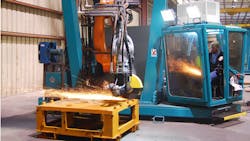Robotic Cleaning or Handheld Grinding? Try Both
Since Vulcan Engineering Co. launched to the (Vulcan Tactile System) VTS™ last January there have been many questions about how to characterize this new type of cleaning equipment. Is it an automated or a manual device? Vulcan has been using the phrase "robotic/manipulator" because it just seemed like an effective description. However, even this label might have caused a few bewildered looks. Simply, the VTS is the best of both worlds and it can be used as a robot or as a manipulator.
Some interested users have seen images of the system and assume that this is just another way to use robots for automation. That’s not quite true.
Although the VTS uses an industrial robot, this system is not meant to be programmed and left alone. The operator does not walk away while the robot does the rest — although, that is one option for this multi-capable system.
Metalcasters know what industrial robots can do, so what makes the VTS different? Using state-of-the-art robotic/manipulator technology in combination with Vulcan’s specialized hand control system, this telemanipulator allows the operator to control the robot’s movements manually. That means the operator moves the robotic devices simultaneously with his own hand movements, performing what truly can be described as a hands-on experience. Cynics might compare this to jogging with a teach pendant, but Vulcan’s hand control system is much different.
First, the operator’s hand position commands the robot’s “hand” (i.e., tool) position. Unlike jogging with a teach pendant (velocity control mode), in which motions would have to be coordinated for multiple axes, the VTS controls provide very smooth and precise movements. Movements can be scaled up or down as needed for the specific task. It’s no exaggeration to say the tool can be moved with surgical precision.
High-Powered Force Sensing
Second, the robot’s tool includes a force-sensing capability, and that reaction is transmitted back to the operator’s hand. This provides the operator with a feel of the forces he is applying with the robot. Another way to illustrate this is to describe the operator as holding the tool on the end of the robot. Wherever his hand moves, the machine is following his motions, performing the work with multiples of force and speed.
The novel design and flexibility of the VTS means that floor operators, though unskilled in robotic programming, gain the full range of control over robotic equipment in fully manual and semi-automatic modes. In addition, this same equipment system, using dedicated fixturing, ordinary robotic programming, and only minor adjustments, also can be applied to fully automatic tasks.
To clarify, the VTS is intended to be a manual machine, a manipulator. But, with a few equipment add-ons, it can be deployed as a fully automatic (i.e., unattended) robot. This might be useful if you have a need for manual processes at some times and automatic processes at other times.
The VTS-G model is an effective example. In this arrangement, the machine is outfitted with a high-power grinding attachment as the robot’s end-of-arm tool. With this, the operator can grind and cut freely around the outside and inside dimensions of a casting. In addition, the whole unit can be moved via stacker crane or railcar, meaning the only limits to its working envelope are the areas that cannot be reached by a crane or where the rails don’t extend.
Putting these features all together, the operator of Vulcan Engineering’s VTS can perform a job manually by using the power of a robot no matter the application.
